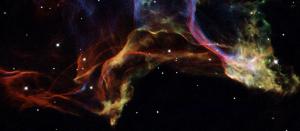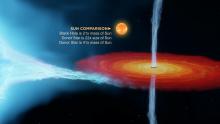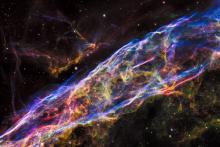Wisps of gas outline part of the Veil Nebula, which decorates the constellation Cygnus, the swan. The Veil is the remnant of a supernova--a star that blasted itself to bits. The explosion probably took place about 20,000 years ago as seen from Earth. Today, the nebula spans about 130 light-years, so much of its material is spread out and faint. [NASA/ESA/Hubble Heritage Team]
You are here
Veil Nebula
When a massive star explodes, it doesn’t just vanish. In some ways, it becomes even more prominent. And it can remain visible for tens of thousands of years.
An example is the Veil Nebula. It’s in Cygnus, which is low in the west and northwest at nightfall. The nebula lines up along the swan’s left wing.
The Veil is the remnant of a supernova — a massive star that blasted itself to bits. The explosion probably took place about 20,000 years ago as seen from Earth.
The star exploded when it could no longer sustain the nuclear reactions in its core. The core collapsed, and the star’s outer layers fell inward, then rebounded. They blasted into space at a few percent of the speed of light.
As the blast ran into nearby clouds of gas and dust, it created shockwaves, heating the material to millions of degrees. The decay of radioactive nickel and other elements forged in the blast added to the light show.
Since then, the Veil has expanded and cooled. Today, it spans about 130 light-years. It’s still visible, though. Colorful ribbons of gas and dust entwine like the strands of a rope. They’ll stay visible for thousands of years.
A lot of the debris isn’t visible to the eye, though. It’s so hot that it produces ultraviolet light and X-rays, which are visible to space telescopes. Combined, the entire complex is known as the Cygnus Loop — the beautiful remnant of an exploded star.
We’ll talk about another kind of stellar remnant tomorrow.
Script by Damond Benningfield
Get Premium Audio
Listen to today's episode of StarDate on the web the same day it airs in high-quality streaming audio without any extra ads or announcements. Choose a $8 one-month pass, or listen every day for a year for just $30.







